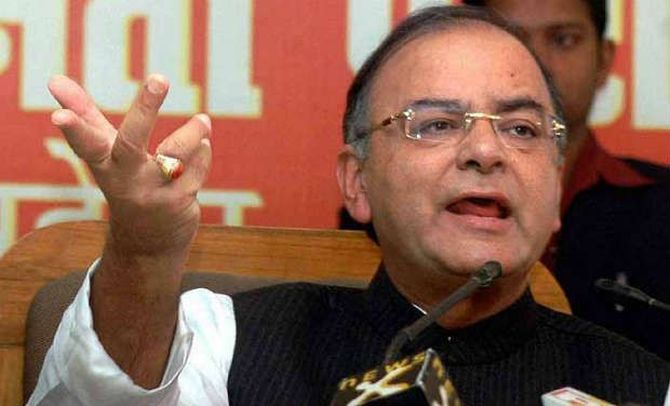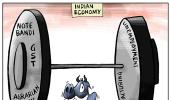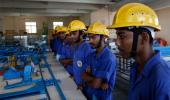'The perpetual challenge is: How to strengthen India's agriculture sector and between making investment in that sector and making agriculture remunerative.'
'The world considers our growth rate to be great. We think it could still be better, we would want it to cross the 8 per cent barrier.'
'The RBI has the highest reserves - is it overcapitalised? Therefore, let there be an expert group to decide how much reserves the RBI keeps and how much goes into the system.'

Finance Minister Arun Jaitley has said that the states were free to announce farm loan waivers if they had the fiscal space, but remained non-committal on the question of a national farm loan waiver scheme as the Centre was facing a tight fiscal deficit situation.
In an interview with Business Standard's A K Bhattacharya for the News Services Division of All India Radio, Jaitley also said there would be no shortfall this year in divestment and non-tax revenues.
He expressed concern over the latest revenue numbers, which showed that the service tax component of the Goods and Services Tax (GST) hadn't grown as the telecom, aviation and real estate sectors were showing weaknesses.
The latest round of bank recapitalisation was aimed at preventing banks from slipping into the RBI's Prompt Corrective Action regime, he said. Excerpts:
What are the top three challenges the Indian economy is facing at present?
They keep changing. Some things are always there in some measure or the other.
For instance, if you had asked me this two months ago, I would have said the major problem is oil prices. That, at least transiently, seems to be behind us. And therefore the effect it had of expanding our current account deficit has receded.
We still have a current account deficit, but it may not be as significant as we thought it would be about two months ago.
Impact of the trade war is not being felt in a major way on India. Initially we were being impacted by the hardening of the dollar. But now, compared to how the US market is doing, and how the dollar is strengthening, we seem to have recovered.
So even when the US markets collapse, it does not impact us in the same proportion.
So I think the challenges we were visualising three or four months ago have shifted.
The perpetual challenge is: How to strengthen India's agriculture sector and between making investment in that sector and making agriculture remunerative.
I think between the affordability of the states and the Centre to do something, India is still at a stage where it is struggling between populism and policy.
The extent of investment still remains a challenge.
I think private investment, which was a major challenge two-three years ago, has significantly revived in the last year or so.
But I was taking a close look at sectors creating a different kind of a problem altogether.
For instance, when we saw the revenue positions, because that determines the ability of the state to provide for the social sector, there is a significant dip in the GST equivalent of the erstwhile service tax collection.
The manufacturing collections have gone up, but the services have not done well. A major part of that service tax earlier used to come from telecom.
Excessive competition has brought down tariffs and therefore the tax collections. The same is the position of the airline sector.
Real estate has slowed, so that is another problem. For the last two months, I can see the impact of no increase in auto sales.
So what looked to be everything in order on the revenue front, there are these four sectors.
Still, in income tax we are moving ahead of the target. But the aforementioned sectors leave the GST behind us, as far as the target is concerned.
We will watch what happens in the next three months.
You mentioned about agriculture stress and you are also aware how the inflation rate has remained benign in the last few years. At the same time, if you look at food sector inflation, food prices are actually falling. What do you think should be the policy mechanism to deal with agricultural distress?
According to me, the policy mechanisms have to enable the farmers to earn more. And whatever support has to be given to them has to be given to their farming and quality of life by the state.
You make life easier and make agriculture remunerative. One part of it we are doing effectively. Namely, improve the quality of life in a village. Give them houses, toilets, electricity, rural roads, gas cylinders.
The second part of it is to invest in irrigation, make loans available to them at the least possible interest, make farm inputs available at a reasonable cost.
And if there is a consensus in the agricultural community, you could also have a support system via the DBT (direct benefit transfer) mechanism, so that leakages can be prevented.
We have to make sure that either the purchase support or income support should be considered if the state can afford that. Spending on irrigation by the Centre and the states is equally important.
Take the case of Madhya Pradesh - a state where you did not have water or electricity 15 years ago. It became an agricultural-surplus state.
Its growth in agriculture year after year was 15-20 per cent. Production increased and the prices collapsed. So the support system of both the Centre and the states had to step in.
Now you need to consider if there is a need to improve on that also, and in what manner.
You talked about an income support scheme. Are you hinting at a Universal Basic Income (UBI) kind of structure for farmers? And what is your view on farm debt waivers?
As far as UBI is concerned, I think one day, as politics of India matures and understands the real issues, it will move in that direction.
When Arvind Subramanian (former chief economic adviser) gave the idea of UBI for all poor in his 2015 Economic Survey, he had the freedom to put it as a thought for the future.
But I said, that today if you do it in lieu of the subsidies, it can work only then. The politics of India will say, give us both. But that is something no system can afford.
If some state governments give a call for a waiver of loans, and if they can afford it, they can go ahead.
But they must keep in mind that if the farmer stops paying, the state has to pay. If that can be done, then the state is welcome to go ahead either as a transient measure or otherwise.
But if the state also does not have the capacity to pay, then the credit cycle may break down.
So every state that is announcing it has to ensure that the credit cycle does not break down.
Because if the banks do not get back the money this year, for the next year's crop how can they give loans?
I do hope that the three states which have announced loan waivers can supplement it.
Is there scope for a national farm loan waiver?
So far we are moving on a tight fiscal deficit, and therefore I would not be in a position to comment on that, but we have taken a position that if a state has the fiscal space, and if it is in a position to do so, it can go ahead.
Are you happy with our current growth rate of around 7.5 per cent? A connected issue is about the low jobs growth.
In the current global scenario, the world considers our growth rate to be great. But in India, we have altered our expectations. We think it could still be better, we would want it to cross the 8 per cent barrier.
Once that happens, it starts reflecting in every area of the economy, there is better job growth. I do believe that when the economy is continuously expanding even at 7.5 per cent, there is bound to be job creation.
We must also keep in mind that when we generally talk about low job growth, there is no authentic data in India, and therefore there is a need to have one.
In the absence of that data, we don't capture what is happening in the informal sector, which is the largest employer.
If you are giving Rs 12 trillion in agricultural loans, if you are giving loans under the MUDRA scheme for small and medium enterprises, it will lead to a lot of activity and self-employment.
You have stayed on the path of fiscal rectitude for the last four and a half years. And you also have promised to meet the fiscal deficit target for this year of 3.3 per cent of GDP. How confident are you at this time of the year?
As far as divestment proceeds are concerned, the Rs 80,000 crore target is comfortably achievable. I don't see any shortfall on non-tax revenues.
On direct taxes, we are set to go ahead of the targets.
On the indirect taxes front, we must keep in mind that we are now in the 18th month of the GST, and the target that we had set for ourselves and the states is a very stiff one, that is from a base year of 2015-16, 14 per cent growth thrice compounded in 18 months.
I have analysed state-by-state performance. Several consuming states, the Northeast in particular, have achieved that. Several manufacturing states have either achieved it or are very close to achieving it.
Examples are Maharashtra, Andhra Pradesh and Telangana. So about 50 per cent of the states have achieved it or are close to achieving it.
There are 15 states that are 10-30 per cent away from the target.
In the third and fourth year of the GST more and more states will get into the achievement zone. The Centre has also foregone Rs 80,000 crore per year by rationalisation of taxes.
In spite of that, the data shows the average monthly collection of the last fiscal was Rs 89,000 crore. This year it is Rs 97,000-98,000 crore. So you still have an 8 per cent increase notwithstanding the rationalisation.
We will certainly be below the GST targets this year, and therefore we can cover it up with disinvestment or direct taxes, or through some expenditure savings - we will have to see.
We are monitoring on a daily basis and I am comfortably hopeful we will be around the 3.3 per cent mark.
What do you think of the compliance rate of taxpayers in India?
India has had a poor record of tax compliance. I think over the past few years, compliance standards have improved as we have taken a number of steps to formalise the economy.
The fact that the income tax assessee base has doubled in five years is a testament to that.
The same is the impact of the GST. Many people have registered themselves, not all are filing assessments, many are filing assessments but not paying taxes.
But at least we are getting a record of their businesses. The fact that we have an increase in the base will lead to behavioural changes in the future.
The government's relationship with the RBI was under focus over the past few months. There were issues about the reserves of the RBI coming to the Centre, there were also issues about the Prompt Corrective Action (PCA) framework. Where do we stand now?
Two principal issues were liquidity and credit. Anybody interested in the welfare of the Indian economy will tell you that over the last few months, liquidity and credit had been a serious problem.
If you have 11 banks that are not seriously lending because they are under PCA, and your standards are more than the Basel norms, which the rest of the world follows, then by squeezing credit, you are squeezing growth.
The power to decide this policy is with the RBI. The central bank is unquestionably autonomous and must remain so. But then, the government of the day, being accountable to the people, has to flag the issue.
We don't intend to take over decision-making. But we have to discuss with the RBI that these are the issues, the power is of course theirs to resolve it.
When we found the RBI not discussing these issues either within the RBI or with the stakeholders in the system, we used all persuasive instruments in our command, be they statutory or non-statutory, to force a decision so that these issues could be fixed.
The PCA framework is an issue before the RBI. The new governor, I hope, takes a view on this. We have, meanwhile, infused extra capital into the banks.
On the issue of the economic capital framework, it is not that we wanted this money to support our fiscal deficit this year.
How much capital and reserves does the RBI require? Even the UPA government had flagged the issue, asking for a discussion. Serious economists have written on the subject.
The RBI has the highest reserves - is it overcapitalised? Therefore, let there be an expert group to decide how much reserves the RBI keeps and how much goes into the system.
Whether it goes into the system for the welfare of the poor or the recapitalisation of banks, there can be a debate on that.
Is there a timeline you have in mind by when both the reserves issue and the PCA issue will be resolved?
The committee is on the verge of being formed. Once the RBI announces it, we will be happy to make sure that it is decided expeditiously.
Are there any performance criteria that you are looking at while doing the latest round of bank recapitalisation?
Our principal objective is to make sure liquidity does not suffer.
There are some banks which are close to the PCA threshold and are in the danger of coming under PCA.
There are some which can come out. So we want to prevent further banks going into PCA and make sure that those who can come out do so.
Then there are some regulatory compliances which are to be followed. Three banks are merging, so because there is a weak bank entering the fray, we need to support them also.
Of the Rs 2.1 trillion bank recap programme you had announced last year, it seems you have fulfilled your end of the promise.
There is some money that the banks will have to raise from the markets. Some have been raised.
But since the market conditions weren't conducive enough, there is still around Rs 42,000 crore left for the banks to raise from the markets.
Coupled with the extra Rs 41,000 crore that we are putting in, banks have a total of Rs 83,000 crore in pending recapitalisation.
There are some questions that have been raised on the future of the Insolvency and Bankruptcy Board of India and the Insolvency and Bankruptcy Code (IBC) process. What is the government's thinking on this matter?
The board has played an excellent role and has performed with great efficiency. It needs to stay on.
The IBC process was a much-needed step. There was a reasonable amount of early harvest. A lot of capital has been retrieved by the creditors.
One is the obvious instrument, that wherever resolution is taking place, you get your money back.
The second is that almost Rs 1.20 trillion has been retrieved when petitions are filed.
Rather than the petitions being admitted and contested, the debtors pay up.
And then another factor, that after Section 29(a) was introduced, a company about to enter the IBC process is paying in order to avoid entry into the IBC process.
A challenge was to set up the institutions, and then expand its capacity.
If there is a case for more transparency in the bidding process, instead of more regulation, let the quasi-judicial bodies decide that. I have recently indicated that let the initial rush get resolved, whether we then need another resolution process that can run alongside the IBC process.
My last question. Soon you will present the 2019-20 Budget. What can we expect?
I cannot comment on that. But I will go by past precedents that in an election year there are certain things you can present and certain things you cannot.











